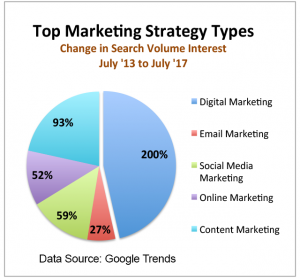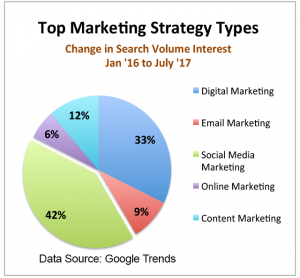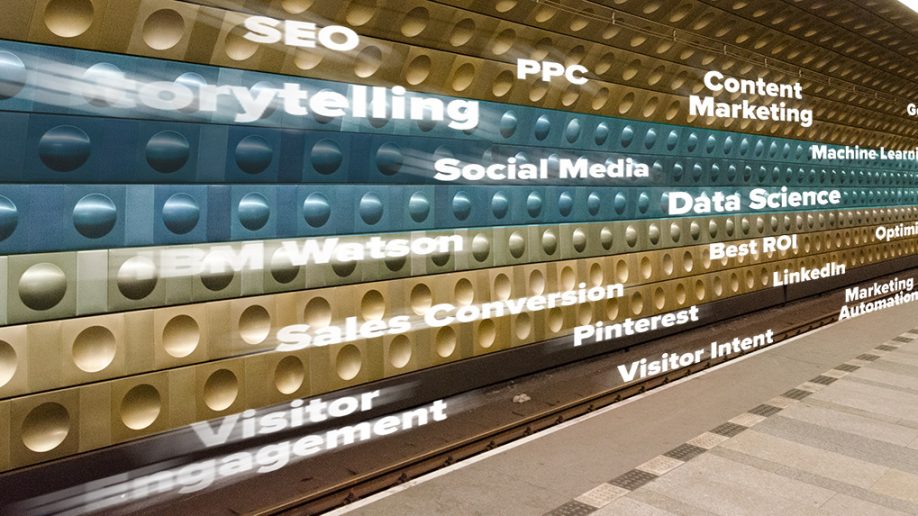Marketing has undergone numerous transformations in the past, with the term-of-the-day ranging from “Viral Marketing”, to “Digital Marketing”, “Content Marketing”, “Holistic Marketing” and numerous others. One company has actually assembled a list of 52 different types of marketing strategy.
But which strategies are being used most today, and which marketing strategies are the most effective at achieving the business results you seek?
According to Google Trends in July 2017, the top marketing strategy terms by search volume are as follows:
1. Digital Marketing
2. Email Marketing
3. Social Media Marketing
4. Online Marketing
5. Content Marketing
2017 Top Marketing Strategy Types
The graphs below show how the popularity of the above marketing search terms have changed over the past 4 years, and from 2016 to 2017.


Yet, while all of the above forms of marketing are still plenty valid today, they are “siloed” to a degree and may therefore not fully address a key consideration for today’s marketing:
Your customer isn’t confined within the boundaries of your marketing campaigns.
Instead, today’s connected customer moves freely across the boundaries of marketing channels, and may be influenced by any or all of them. The customer journey may therefore include numerous touch-points that will ultimately influence their buying decisions. In many cases today, this will include word-of-mouth marketing, mobile marketing, and even marketing automation.
Consequently, marketers must fully understand how to integrate their marketing to facilitate this customer journey, and deliver a superior customer experience. This means orchestrating a seamless experience across channels and devices, without missing a beat.
Nevertheless, this “orchestration” does not happen on its own. It requires data-driven marketing strategy, and the application of analytics tools to quickly distill actionable insights. Optimal results can be achieved when we are able to orchestrate that process to create mutual value that advances the customer relationship. I refer to it as Holistic Marketing.
Holistic Marketing defined
Holistic Marketing integrates all aspects of marketing strategy to deliver a relevant customer experience that leads to a greater exchange of value while nurturing the customer relationship toward brand preference.
What do we mean by a relevant experience? Simply put, a relevant experience is aligned with customer expectations, and in the context of a website visit – aligned with visitor intent. Ultimately, that means delivering the value that your customer (or visitor) expects, based upon the messaging you have projected.
That may sound simple, but today there are so many marketing and advertising tactics that fail to achieve that constraint. Just look at the plethora of off-topic content that we must deal with every day to access the information we seek. We must frequently navigate landmines of irrelevant ads and unrelated content to get to a recipe, or maybe to understand what illness our child’s symptoms could point to.
Nevertheless, many companies call these tactics part of their “business model”. Yet they are rarely aligned with customer intent. On the contrary, those tactics come with a cost. The cost of a poor user experience, lost productivity, network bandwidth costs and potentially the lost goodwill of a visitor.
How is a holistic approach different?
A key difference between a holistic approach to marketing and other forms of marketing, is in its ability to deliver more value throughout the customer journey. So while a PPC campaign strategy may include goals to optimize for conversion, a holistic marketing strategy will leverage that PPC campaign within the broader context of the customer journey. Depending upon your business, that may mean an introduction to your brand, a remarketing reminder, or a way to reconnect. That not only requires insight, but knowing how to apply it to enhance the user experience. Furthermore, with a holistic marketing approach, every touch-point should be seen as an opportunity to build upon insight.
Aligned marketing experience > mutual value > build trust
= growing relationship
The 10 Pillars of a Holistic Marketing Approach
While implementation details and priorities will vary across companies, the following foundational elements should be considered with any holistic approach:
1. Keep Your Strategy Evergreen
In 2018, nothing is static. What worked yesterday is now a competitive disadvantage. Knowing what is possible, and what your customer expects, will “set the bar” to shape all areas of your strategy.
2. Pinpoint your targeting
Translate your value proposition to your key target audience segments with the precision of data-insights versus intuition. Clearly define how will you differentiate your offering from your completion.
3. Adopt a customer-centric viewpoint
Yes, that buzzword has been around for a while. But if you are like many marketing leaders, you probably know your business too well. Put yourself in your customer’s shoes. What are their needs, and what pain points do they have? What problem will your product or service solve? Does the customer see it that way?
4. Map the Omni-channel Customer journey
Think about the steps to the sale and your sales cycle. How does a customer first engage with your company? What touch-points exist (online and offline), and what is the customer looking for at each step? What experience will cause them to advance to the next relationship stage vs. go elsewhere. How much time exists at each stage, and what are the influencers? What can you offer at each stage to facilitate and streamline the process?
5. Use Data Science to gain ongoing actionable insights
Distill insights from past campaigns. That means not only from your own company’s experiences, but from industry norms when that data is available. Where have your successes come from, and what hasn’t worked so well? How can data science tools help you predict what is likely to happen next. Consider all forms of marketing that your company has engaged in, as well as those it should be engaged in.
6. Identify the gaps in your strategy
What are the gaps or weaknesses that you currently have. Is your marketing strategy solid? If so, do you have market momentum? Are you missing any key resources or expertise? Even with a winning strategy, other gaps may exist that limit your ability to execute. Budget is can be an obvious one. Other gaps may fly under the radar because you know your business so well. An objective third party can sometimes provide those missing insights.
7. Opportunity assessment
Getting a favorable ROI on your marketing spend means knowing where the low hanging fruit is. Look for the quick successes that will build organizational knowledge and support sustainable growth. Be sure to consider any timing and seasonal opportunities.
8. Align with business goals
Of course your marketing must support your business priorities. Do you need to boost leads, conversion rates, cross-sell and up-sell revenues, or improve retention rates? Your marketing programs will be more easily justified when they can be tied back to business impact.
9. Analytics Strategy & Metrics
How will you measure the success of your marketing programs? What are your KPIs, and are you collecting the right data to support them? Do you have the tools in place to quickly distill insights? Is your team confident that it knows the right metrics to focus on to produce the business impact that you seek?
[DISABLE InfusionInlineBanner img=’http://holistic.marketing/images/test.png’ ]
Digital Customer Journey Whitepaper[/InfusionInlineBanner]
[CTA type=’banner’ title=”Lets Start” subtitle=”A Conversation!” header=”Contact Scott” cta=”contact2″ icon=”fa-chevron-circle-up” img=”/images/ScottPete-phi.png”]
Second format:
[CTA title=”GET THE DETAILS!” subtitle=”Download the whitepaper” header=”Download Now” cta=”dl_001b” img=”/images/cta_DL001.png” btntext=”Download Now” ]
THIRD format:
[CTA type=”formRight” img=”/images/ScottPete-phi.png” btntext=”Download Now” title=”Digital Customer Journey2 Whitepaper” cta=”dl_004″]
FOURTH format (before 3rd because can’t have dupe ID’s and we DO!)
[CTA type=”formLeft” img=”/images/ScottPete-phi.png” btntext=”Get Quote” title=”Lets start a conversation” cta=”contact3″]
10. Embrace Action-Enabled Marketing
Insights are great, actionable insights are even better. Know what actions you will take when when you detect a change in a key metric / KPI.
Today data and marketing tools provide more opportunities than ever before. Opportunities to create more value, and the potential to even overstep boundaries.
For a holistic marketing approach, your strategy should strive to make everything you do tell you a little more about your customer, and then to apply that insight to deliver more relevant value.
Companies that use data-insight wisely, and responsibly, stand to make gains in the trust and loyalty of their visitors and customers. That in turn, leads to more brand advocates, more profitable relationships, and greater competitive advantage.



Leave a Reply